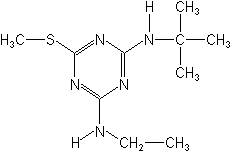| Common
Name: |
Terbutryn
|
| Chemical
Name: |
N-(1,1-dimethylethyl)-N′-ethyl-6-(methylthio)-1,3,5-triazine-2,4-diamine
|
| CAS
No.: |
886-50-0
|
|
Structure: |
 |
| Molecular
Formula: |
C10H19N5S
|
| Molecular
Weight: |
241.4
|
| Physical
Chemistry: |
Terbutryn is a white or colorless crystalline powder with no distinct odor.Water Solubility: 25 mg/l at 20 degrees C.Solubility in Other Solvents: Readily soluble in isopropanol, xylene, dioxane, chloroform, carbon tetrachloride, and acetone. Melting Point: 104-105 degrees C.Vapor Pressure: 0.225 mPa (25 degrees C).
|
| Toxicity: |
Terbutryn is slightly toxic.The LD50, is 2450-2500 mg/kg for rats and 3884 mg/kg for mice. The LD50 for dermal exposure is greater than 2,000 mg/kg for rabbits.The concentration in air which kills half of the test animals by inhalation, the LC50 (4 hours), is greater than 8 mg of an 80% formulation per liter of air for rats. Terbutryn is not a skin sensitizer.
|
| Application: |
Terbutryn is a selective herbicide and a triazine compound. It is absorbed by the roots and foliage and acts as an inhibitor of photosynthesis. Terbutryn is a preemergent and postemergent control agent for most grasses and many annual broadleaf weeds in winter wheat, winter barley, sorghum, sugarcane, sunflowers, peas, and potatoes. It is also used as an aquatic herbicide for control of submerged and free-floating weeds and algae in water courses, reservoirs, and fish ponds.
|
| Technical
Purity: |
95%TC
|
| Formulation
Type: |
80%WP,50%SC
|
|



